
#5 of lockers and fishing boats, fishermen and those who love them ...part B (for part A, please read first)

And so, alas, 'twas in the Shetland Islands, after I walked down the cobblestone path through the narrow village walkway from atop the hill that fine October day, that I reached the harbor in the town of Lerwick and made my way excitedly down the modern dock to the F/V Swan LK243, the boat on which my next Shetland Wool Week knitting class would take place.

I just remember walking along the planks of the wooden ramp that early morning and taking a big long deep breath just to really take it all in. I was so happy and grateful to be where I was right then and there.
And then, there it was, as clear as could be, "the diesel and the docks", and though half way around the world in an unfamiliar place, the fragrance spoke to me like the voice of a familiar friend. Just like that day of Nathan's hug, I was somehow reminded of other places and other times, and there was something quite endearing and comforting about that and the start of this very special day.


Grinning from ear to ear at this point, I joined the group as we were aided on board by the crew with our satchels of yarn and knitting. One by one we climbed onto the boat and down into the cabin. Here to take a class on Dutch Ganseys with Stella Ruhe, pictured below, the group of us from the UK, Europe and abroad arranged ourselves in the galley on benches squeezed around a small wooden table, rocking slightly with the lilt of the ocean, even though we were still tied up to the dock for the day.

Knowing nothing about the boat, its history or much about the fishing industry in Shetland, I assumed the Fishing Vessel Swan LK243 was still actively being used for fishing. At one point, as we were getting settled, I asked the skipper more about the boat and fishing life. Of course I wanted to know more about “his” boat and what he fished for and how they fished in the Shetland Islands. I thought myself somehow a compatriot of sorts, though I truly had no idea. I was wide eyed in general about being in this new place and so much to soak in, but so eager to connect to this place at 60 degrees latitude (just like Cordova) and what we held in common, ie: fishing for a living. Besides that, it was such a charming little boat, and I was somehow caught in this romantic nostalgia enhanced by the atmosphere and surroundings.
Ah yes, without a word at first, in answer to my question, the skipper patiently motioned me back up the stairs and up on the deck. In all honesty, I thought he was taking me up to show me his nets or something, but instead, he simply pointed in the direction of a VERY large vessel, at least 300 feet long on a MUCH larger dock off in the distance, and explained to me that although the Swan LK243 was at one time used as a herring boat, that these days, the herring fishery was performed by a few mega boats such as the one off on the distant dock and all is accomplished in just a few days of the year. He told me that the boat we were on was actually owned by a historical trust and that it’s fishing days were long gone. So sad I thought.
With that I returned down the stairs and back around the table, reflecting on the skipper's news and listening to the mesh of voices and accents from Shetland and Fife in Scotland, London, Suffolk, and Cullercoats in England, the Isle of Man, Denmark, and New Zealand as we all handled and studied Stellas's swatches and discussed the pattern ideas and were inspired by her stories of the Dutch ganseys that grew out of the herring fisheries in the UK.
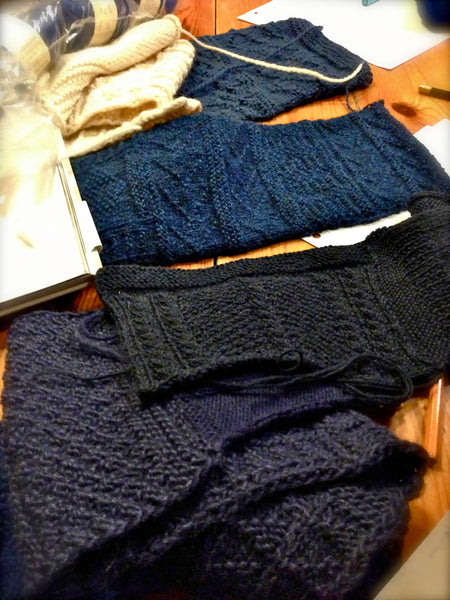
Her words “follow the fish, follow the patterns, follow the herring trail and you will find the trail of knitting patterns that spread through this region" sunk deep into my heart and mind.

As mentioned before, Stella is an enthusiastic speaker. She is genuinely excited about her topic and what her research has revealed, and even now in the midst of a second collection of ganseys collected from Holland. She was a diligent detective and investigator, hunting and searching out photos and digging up clues as to the origins and evidence revealed by these garments she so eagerly sought. With little physical evidence left behind, she relied on the photos she uncovered through her research, and reknit them based on what she could see in the photograph. One reason she cited for so few being around, at least in Holland, was that they were worn until they were worn out, and that once a gansey became no longer able to be worn, the fisherman would often use it as a deck mop at the end of a stick.
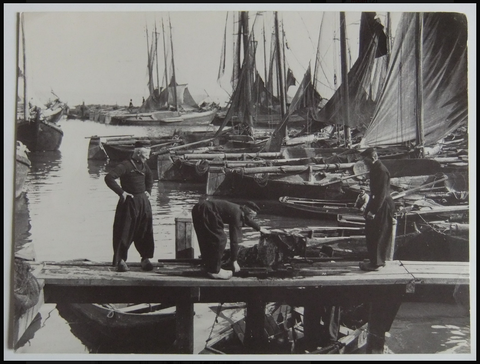
One of my favorite stories and photographs she shared with us concerned the pompoms that were on the end of some of the men’s gathered gansey collars. It was odd and amusing to see these grown men with pompoms hanging from knitted strands tied in a bow on the front of their garments. As she explained the reasoning for the pompoms, I had to laugh to myself, as they weren't a decoration as I had assumed, but rather they were there to wipe away the jellyfish that would land in their eyes as they brought up the nets, and the drawstring were there to help draw up and secure the neckline. Beginning with the basic elements they found in the UK sweaters , these Dutch women who had knit the sweaters had added practical special touches of their own at the request of their fishermen husbands to help them as they worked, implementing their own tradition and creating a Dutch gansey knitting heritage.
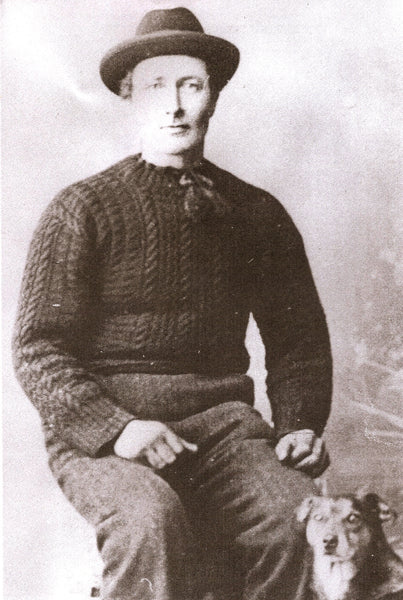
As she spoke, still caught in an emotional fishing memory state, I was once again mentally transported to the days on the back deck of our seine boat, stacking the leadline, one of my jobs, and to the unforgettable memory of the hurtful sting from the jellyfish as the net came over the power block splattering jellyfish bits into our eyes. Right then, glancing at the photographs I felt an immediate connection to the gentlemen in the old photographs, for we shared the sting of the jellyfish, as well as the connection to their knitting wives with their desire to care for their loved ones via their knitting. If you look closely in the second photo below you can see the bits of peachy gold in the net, which are the bits of jellyfish.
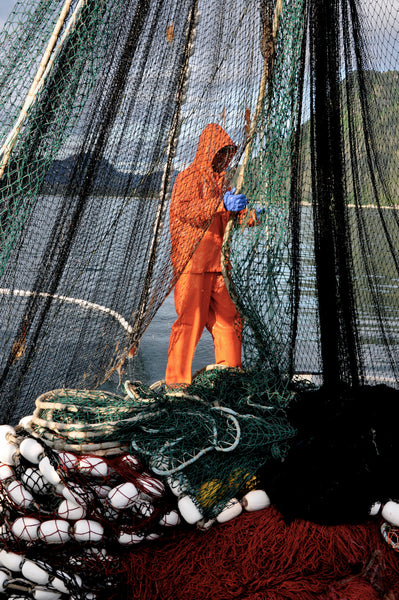
The class was wonderful and halfway through, we all shared a delicious potato and smoked haddock soup with home made bread cooked for us by the "galley girl". After Stella's introduction and history lesson concerning the Dutch gansey version and how they came about, she further elaborated on the graphic designs that were incorporated via knit and purl in a way that varied from gansey to gansey.
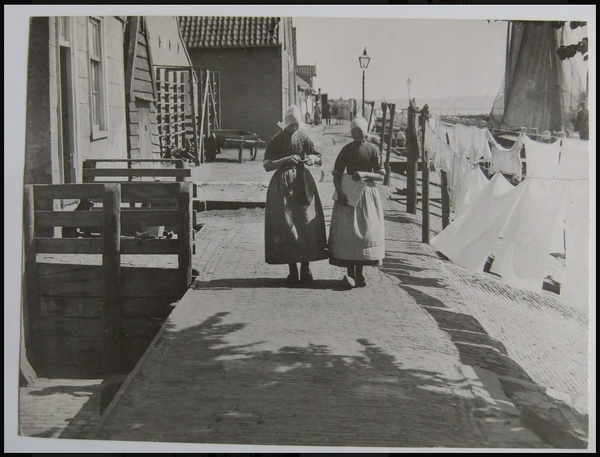
These ganseys were "a reflection of life, fishermen, and their families". I think I continued to be most struck by the willingness of the Dutch women to make it their own and to comfortably adapt the patterns in a way that genuinely personalized them as they interjected their own motifs and that which they held important as translated graphically into their designs.

In light of this, as part of the workshop, instead of merely copying their ideas, Stella invited us to think about what we felt was important in our lives, and how we might graphically translate those values and images into simple patterns. WIth graph paper and pencil, then yarn and needles, we set about to reflect on this and bring our own ideas to life.
She also spoke about the garment she was wearing which wouldn't be immediately identified as a gansey, in the traditional sense, for it incorporated the essence of a gansey, yet looked completely modern and contemporary. In the quiet moments that followed, as I began to knit my swatch, I mentally wrestled with this myriad of thoughts concerning traditional, contemporary, fishing, fisherman, fishing boat, fishing towns, old patterns, new patterns then, now, now then...I wondered if anyone else's head was spinning as fast as mine was right then.
What rattled around in my mind was the thought of this fiber (ie:wool), this wonderful fiber with these wonderful qualities and how it was incorporated into a garment and personalized via the handknitter and worn by loved ones. I thought again as I had the night before when Stella had given her talk, that the Dutch gansey, in regard to actual fisherman was shrouded by these words, “was” “in the past” “historically” “traditionally”, and yet Stella was weaving together past and present in regard to ganseys.
Yes, it is true, ganseys ARE still around, and I do see ganseys and their influence all the time in the knitting fashion world, modified and unmodified, but what about the fishermen? If these were fishermen sweaters originally designed and worn by fishermen, then why weren't more fishermen still wearing them? The first realization, at least for today, was that at least here in the Shetland Islands, there weren't a whole lot of independent fishermen anymore.

Hmm....The pat I had felt earlier was no longer a pat, it was a lump in my throat. This is precisely what went through my mind.
- We are a fishing town. It is our proud identity.
- We bring a healthy sustainable product into the hands of the consumer.
- We are more than historical, and we are continuing to make history.
- We are an active, living, and thriving coastal fishing community and state in an industry where independent fishermen in small boats are presently harvesting an unadulterated product that is nutritionally superior than its farmed counterpart.
- We are knitters by choice and desire.
- We love to knit and we love to knit for those we love.
- Wool is a superior fiber with superior qualities, ideal for those working in cold and wet environments and we are a cold and wet environment.
With all this in mind, why could we as handknitters not put all these together once again in a way that was somehow new and different and incorporated our unique and special Alaska harvesting heritage?
The words, “working in wool” came to my mind. Just as the Moray Firth Gansey Project was about ganseys of the past, why couldn’t we have a project that clothed the fishermen of the present. Just as the Dutch women modified the patterns that they came in contact with that followed the fishermen on the herring trail and integrated them with their own designs and modifications and had implemented their own tradition, why couldn’t these patterns follow the fish once again and come to OUR fishing port and OUR fishing fleet, and be modified by our local hand knitters for an active present fisherman?


Simply put, why couldn’t we put fisherman sweaters back on the backs of the fishermen?

Wouldn’t it be ideal to not only knit my fisherman son, daughter and son in law each a gansey ( I promise, no pom poms...), as I have thought and wanted to do for awhile now, but also to pull together and collectively knit as a group wool gansey sweaters that we designed ourselves for our fishermen and outdoorsman loved ones to work in. I know this is nothing new and that there have been those in our town who have knit for their fishing family members for years, but this would be something we could do together as a group, just for fun as well as function, and maybe not just for us, but eventually we could ignite from Cordova an idea that could spread amongst this next generation of other Alaskan fishing communities as well.
The one thing that is taking place in our industry is the attention drawn to the care that our fishermen are purposely tending to the fish they catch in order to preserve best the quality of their product. What better way to care for these harvesters than to clothe them in that which is made with care and purpose. As I continued to knit, my mind mulled over all these thoughts. Sitting on the benches of that boat, rocking gently with the water, I felt both calm and excited at the same time.
As class came to a close, I climbed up the ladder and out of the cabin of the F/V Swan LK243 and into the ocean air. Once again, the diesel and the docks swept over me reminding me of the fishing life back in Alaska, and more questions filled my mind. With all this talk of ganseys, I wondered if ganseys were ever worn long ago by the fishermen in Cordova, or anywhere else in Alaska? And for now, would there be a way to combine these ganseys with our wonderful local Copper River Fleece gear in a way that would bring out the best of both worlds?

And so from all the taps on my shoulders and pats on the back, and beyond the lump in my throat, I began to put to words what had been stirring within all week, now grown from concept and idea into something tangible, so much so, I almost felt I could touch it..
I traveled back to my little cottage that night full of ideas and wrote in my travel journal about the day's adventure. I looked over my notes from Stella's class as I wrote and came across these words that I had written down, which she had shared concerning the growth of her idea and what was going on in her mind as she was just getting started. As I reread them, I felt a bit of myself in them, "...but if I don't do it, what would happen?" How I could relate. These words seem to be what has kept me doing so much of what I have done over the years in The Net Loft, and although inadequate in so many ways, I always have thought to myself, "it might not be perfect and someone else could probably do it a whole lot better than me, but if I don't do it, what would happen?".
What was even more interesting were the next words in my notes that I had jotted down and put in quotes from her sharing. It was just a phrase..."With enormous joy in my heart". I wrote this down because she was so beaming in describing the journey she had taken in making the Dutch Gansey Project happen. I believe it wasn't just an impersonal and technical study on sweaters, but rather it was the stories about them and the people in and around that brought them to life that brought her joy. It was the joy she found of the human experience and the people she met along the way, those from then and those from now, as she unraveled the Dutch gansey story.
Stella's excitement and passion concerning her project is that which happens when we follow that inkling, that tap on the shoulder, that pat on the back, that lump in the throat, even when we are not so sure always what we are doing or where it will take us. Thank you Stella for an inspiring day...
Finally, before dropping off to sleep, touched and inspired again by the hand knitters who came before me, and from all that led up to this day in Shetland and in my own fishing and knitting life, the closing words I wrote at the bottom of the page of my journal posed a simple question... "What about a Cordova Gansey Project?"
Well...why not?
Stay tuned…#6
As a sidenote, from a recent correspondence with Stella, she now has 125 sweaters in the Dutch Gansey Collection that are hand knit reproductions of Dutch ganseys found in old recovered photographs, and is just as excited about her second book in the making as she was the first, which promises more stories of life and living conditions on the herring boats in the early 1900's, and further history of the life and times of these fishermen and their families. To be published in the future initially in Dutch, here's hoping an English translation will soon follow.

top photo from: http://www.historiegaasterland.nl/Sites%20hist.archief%20%20HWG/Haringvisserij.html
bottom photo: http://www.geheugenvannederland.nl/?/nl/items/ZZM01:F021570/&p=44&i=19&t=911&st=breien&sc=(breien)/&wst=breien
all other archival Dutch Photos courtesy of Stella Ruhe Dutch Ganseys

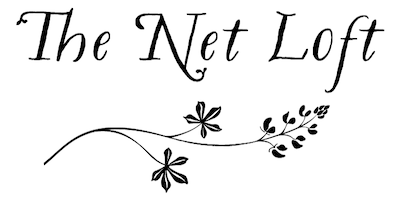




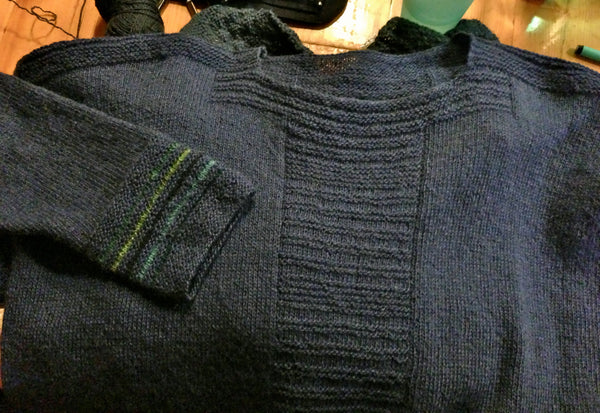
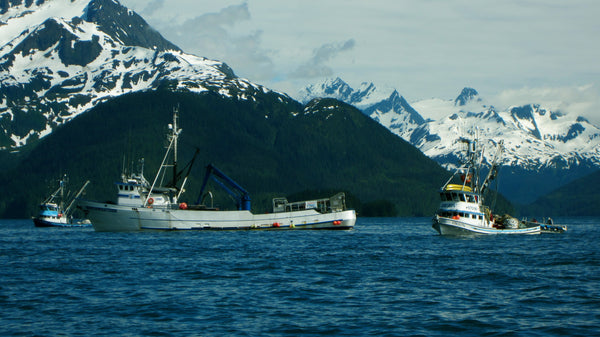
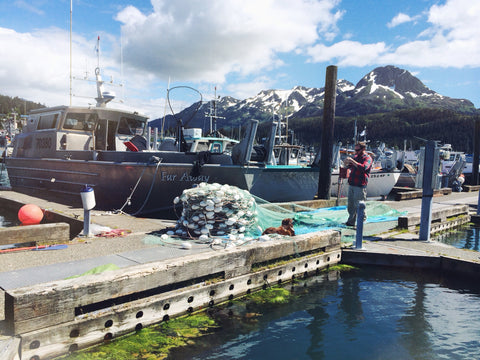

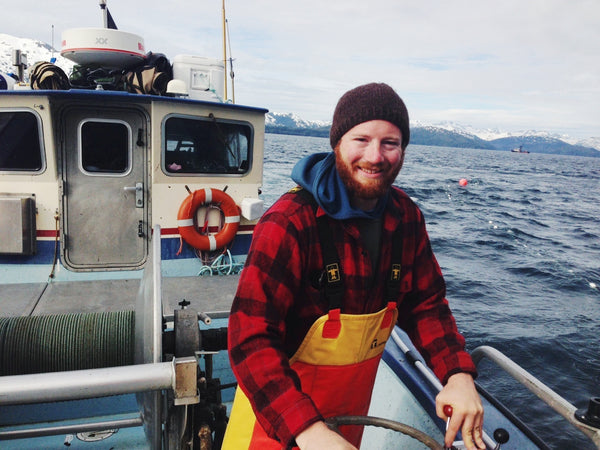
5 comments
Thank you Anna. I am glad you were inspired. It is a LONG read. Thank you for taking time to read it through the unfolding story, and understand the essence and driving forces behind the project. I appreciate your comments.
So beautiful and inspiring. Thank you so much!
Thanks Pam and Kymm,
We will post some ideas for those outside our area to participate. We start in town here the first weekend of June with a pilot group of twenty. Follow along on the blog as the story continues to unfold. Thanks for your comments. We will keep you posted.
I love the idea of a Cordova gansey project. My son and daughter in law fish our of Cordova and I am a avid knitter. Please put me on your mailing list. thanks and happy knitting
I can hardly wait to see the Cordova Gansey Project come into being!